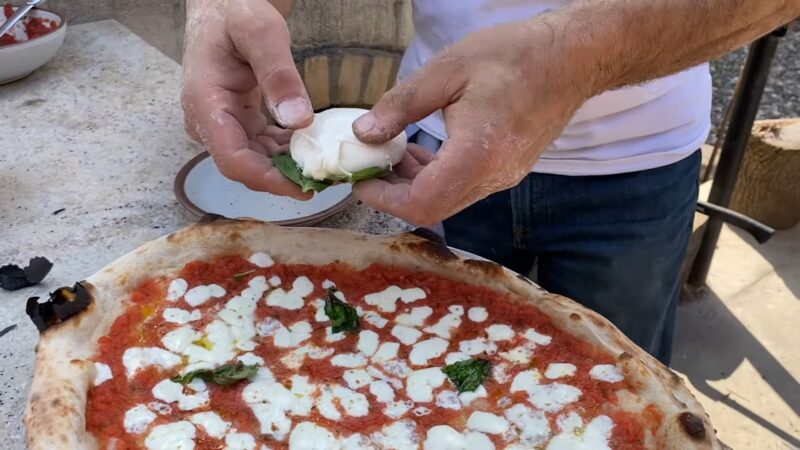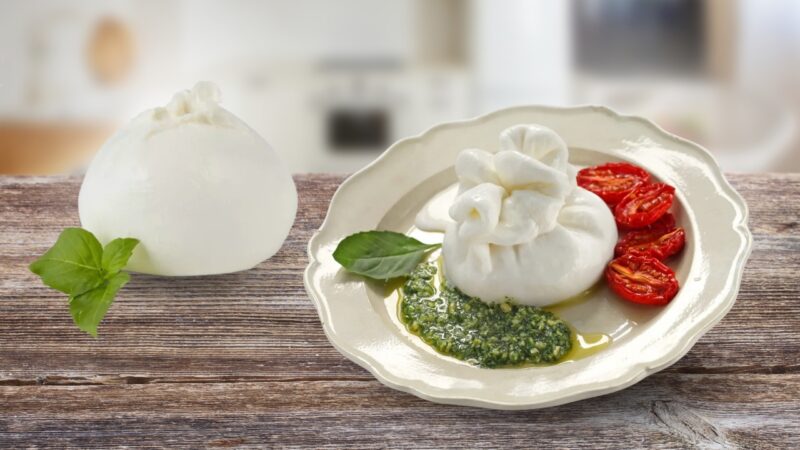Welcome, culinary aficionados and globetrotters alike! I’m thrilled to introduce you to one of Italy’s most exquisite gastronomic treasures—burrata cheese. With its rich, buttery flavor and dreamy texture, this Italian specialty is poised to steal your heart and palate alike.
The Dawn of Burrata: A Taste of History

The burrata cheese tale begins in the sunny Italian region of Puglia, more precisely in the early 20th century. Originally, burrata was a humble attempt by frugal farmers to minimize waste and make full use of leftover mozzarella scraps.
This ingenious idea soon morphed into one of the most beloved cheeses worldwide. Fast forward to today, and burrata is a centerpiece in many gourmet recipes, from the simplest to the most intricate, pairing well with a variety of ingredients and seducing palates with its unique, creamy taste.
The Anatomy of Burrata
Before we delve into the taste, let’s take a closer look at what this cheese actually is. Burrata begins as a pouch of stretched mozzarella curd, into which a mixture of fresh cream and cheese curd shreds (“stracciatella”) is stuffed, creating a soft and indulgent center.
The outer shell is solid mozzarella, while its core holds the creamy, milky treasure. This exquisite duo gives it its distinct texture—a delicate contrast between the solid exterior and the oozy, creamy interior.
Tasting
When you first bite into burrata, it’s akin to embarking on a sensory journey. The smooth, firm outer layer is akin to a classic mozzarella, exuding a soft, milky flavor. But the real magic lies within.
The creamy interior is a concoction of flavors that offers a pleasing contrast to the outer shell. It is buttery, rich, and subtly sweet, with a hint of tanginess that brings balance to its overall flavor profile.
The Complexity of Flavor
Burrata’s flavor profile is not just about the creaminess. It’s a layered and complex experience. Some key taste notes you’ll find in burrata include:
- A subtle sweetness, almost akin to fresh milk
- An undercurrent of tanginess, reminiscent of a good quality yogurt
- A rich, buttery flavor that makes it stand out from other cheeses
Texture and Mouthfeel: The Unforgettable Embrace
Burrata’s texture is just as important as its flavor. The initial firmness of the mozzarella shell gives way to a delicate creaminess that is almost luxurious. It is this juxtaposition of textures that makes eating burrata such a unique and enjoyable experience.
When you cut into this cheese, the creamy core slowly seeps out, enticing you with its promise of rich, creamy goodness. Once in your mouth, the creaminess envelops your palate, providing a counterbalance to the firm yet yielding outer shell.
Pairing Burrata: Perfect Companions
Burrata is incredibly versatile when it comes to pairings. Some of the best traditional Italian accompaniments are ripe tomatoes, fresh basil, and a drizzle of quality olive oil.
However, its flavor and texture also stand up to more robust partners, such as prosciutto or roasted vegetables. For a touch of sweetness, pair burrata with seasonal fruits like peaches or figs and a drizzle of honey.
In the wine department, a crisp, fruity white wine like a Pinot Grigio or a light red like a young Chianti makes a perfect companion.
Burrata in Cuisine: A Star Ingredient
From pizza toppings to pasta fillings and from salads to appetizers, burrata has made a significant mark on the culinary map. Its rich creaminess enhances the flavor of any dish it graces. A few must-try dishes include:
- Salad with heirloom tomatoes and fresh basil
- Pizza with prosciutto and arugula
- Pasta with a simple garlic and olive oil sauce
Storing: Keeping the Freshness Intact
Burrata is best when eaten fresh, preferably within 24 hours of opening. However, if stored properly in the refrigerator, in its original brine, it can last for a few days.
Remember, once cut, burrata begins to lose its moisture, and the texture can become grainy. It’s best to consume it all once you’ve cut into it, which, given its delicious taste, shouldn’t be much of a problem!
Cooking at Home: An Artisanal Adventure
If you’re an adventurous home cook, you might enjoy the challenge of making burrata cheese at home. Although it requires some effort, the result is well worth it. You’ll need high-quality ingredients: fresh cow’s milk, rennet, citric acid, cream, and a bit of patience.
Remember, the key to perfect burrata is achieving the right balance between the firm mozzarella shell and the creamy stracciatella filling.
Nutritional Value
Burrata cheese is not just a feast for your taste buds; it’s also a decent source of nutritional benefits. It’s high in protein and calcium, providing essential nutrients for muscle function and bone health.
However, this type of cheese is also high in fat and calories, so it’s best enjoyed in moderation. Always remember: even the best things in life must be balanced!
Spotting Authentic Burrata
To ensure you’re getting the real deal, check the product’s origin. True burrata comes from the Puglia region of Italy. Some quality indicators include the DOP (Denominazione di Origine Protetta) label, a certification that guarantees its Italian origin and quality.
Apart from this, genuine burrata should be sold in a liquid solution to preserve its freshness, and its flavor should be milky and buttery with a delicate sweetness.
Unusual but Delightful Pairings
While traditional pairings with burrata are fantastic, it’s worth exploring some unconventional companions. Try it with roasted beets and a sprinkle of pistachios, or top it on grilled peaches for a perfect summer treat.
Alternatively, serve burrata with warm bread and a drizzle of truffle oil for an utterly luxurious experience. The creamy cheese is a beautiful canvas for playing with flavors and textures.
Cooking with Burrata: Pro Tips

When using burrata in hot dishes like pizza or pasta, add it at the last minute. This cheese’s magic lies in its contrasting textures, and you don’t want to lose that by overmelting it.
Also, remember that this cheese is rich and flavorful on its own. When creating dishes with it, ensure the other ingredients don’t overpower but complement and enhance its unique flavor.
The Perfect Burrata Platter: For All Occasions
Whether you’re hosting a casual dinner or an elegant party, a burrata platter can be a showstopper. Start with fresh burrata; add some ripe cherry tomatoes, fresh basil leaves, and a drizzle of olive oil.
Enhance the platter with a selection of charcuterie, olives, artichoke hearts, and fresh fruits. Serve with crusty bread or crispy bruschetta. Remember, the key to a great platter is a variety of textures and flavors that enhance the star—burrata.
Final Words
Burrata is a cheese like no other. Its unique composition of a mozzarella shell filled with creamy stracciatella makes it a culinary gem that delivers a distinctive taste experience—a delicate balance of sweetness, tang, and a creamy mouthfeel that lingers long after the last bite. Whether you’re a novice or a seasoned gourmand, burrata is a cheese that absolutely deserves a place in your gastronomic repertoire.

